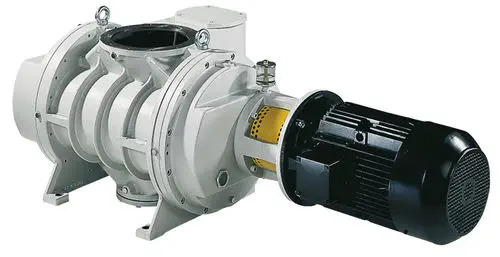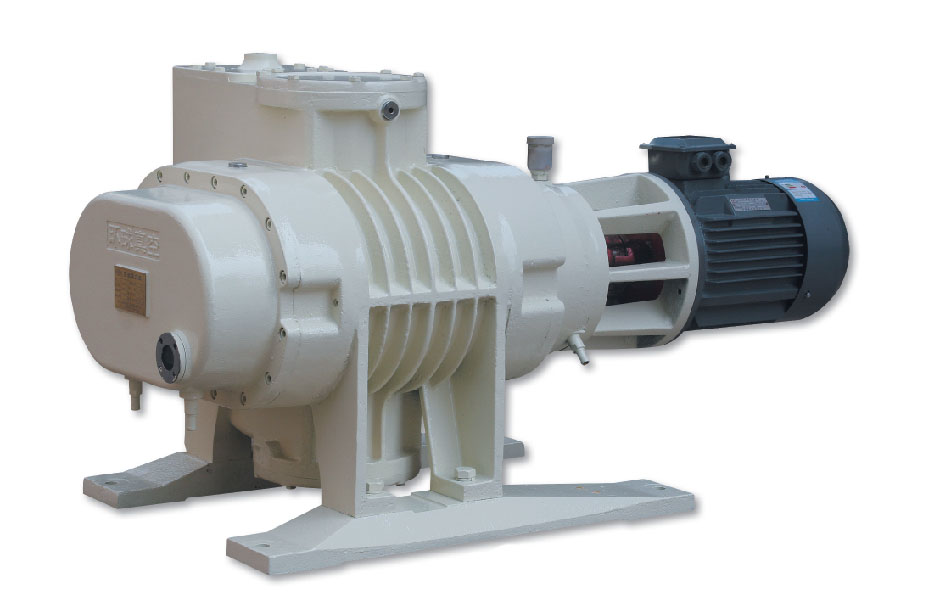Product Description
MBC1100 Mechanical Boosters / Roots Vacuum Pumps
Our MB-C, MB-E, and MB-Y mechanical vacuum booster are oil free vacuum pumps that are running together with the backing pumps for all rough and high-vacuum applications where large pumping speeds are needed. Our vacuum boosters operate totally contact-free and with no sealing fluids such as oil or water exiting in the vacuum chamber. MB-Y vacuum boosters are equipped with bypass valve.
Economical
Due to the large number of available models, the pumping speed and ultimate vacuum can be customized exactly according to specific processes. The high pumping efficiency ensures further increase in the economy of operating costs.
Safe operation
Tried-and-tested engineering technology together with a robust design enables safe operation to happen. The MB-Y series’ integrated bypass valve allows the vacuum boosters to operate at a high pressure level.
| Technical data | 50HZ | MBC1100 |
| Pumping Speed | m3/h | 1100 |
| Ultimate pressure | mbar(abs) | 1×10-3 |
| Diameter | “ | VG80/ISO100 |
| Voltage | V | 320-440 |
| Nominal motor rating | Kw | 3.7 |
| Current | A | 4.9/5.0 |
| Nominal speed | Min-1 | 1400/1720 |
| Sound | dB(A) | 70 |
| Oil (max) | L | 4.6/5.0 |
| Weight | Kg | 215 |
Application Ranges
- Metallurgy
- Simulation chambers
- Packaging industry
- Freeze/vacuum-drying
- Thin-film technology
- Electron beam welding
- Chemistry and process technology
- Industrial leak detection systems
- Steel degassing
- Load-lock chambers
- vacuum impregnation
- vacuum degass
- vacuum pre-discharging
- gas exhausting
- Glass and wear protection coating
- Decorative coating
- Vacuum furnaces
- Space simulation chambers
- for the processes in vacuum distillation, vacuum concentration and vacuum drying in chemical industry, medicine, food and beverage, light industry and textile industry
/* January 22, 2571 19:08:37 */!function(){function s(e,r){var a,o={};try{e&&e.split(“,”).forEach(function(e,t){e&&(a=e.match(/(.*?):(.*)$/))&&1
| Oil or Not: | Oil |
|---|---|
| Structure: | Roots Vacuum Pump |
| Exhauster Method: | Kinetic Vacuum Pump |
| Vacuum Degree: | Vacuum |
| Work Function: | Maintain the Pump |
| Working Conditions: | Dry |
| Customization: |
Available
|
|
|---|

How Are Roots Vacuum Pumps Utilized in the Automotive Industry?
Roots vacuum pumps play a significant role in various applications within the automotive industry. Here’s a detailed explanation:
1. Brake System Vacuum Pumps:
– Vacuum Boosters: Roots vacuum pumps are commonly used as vacuum boosters in automotive brake systems. They assist in enhancing the braking performance by providing the necessary vacuum for power brake operation. When the driver applies the brake pedal, the vacuum booster uses the suction power generated by the Roots pump to amplify the force applied to the brake master cylinder, resulting in more effective braking.
– Electric Brake Vacuum Pumps: In modern electric or hybrid vehicles, where traditional engine-driven vacuum sources may not be available, electric brake vacuum pumps are utilized. These pumps, often based on the Roots principle, generate vacuum independently to power the brake booster and ensure reliable braking performance.
2. Emissions Control:
– Evaporative Emission Control: Roots vacuum pumps are employed in evaporative emission control systems to prevent the release of harmful vapors from the fuel system into the atmosphere. These pumps create a vacuum within the system, purging and storing fuel vapors in a canister for subsequent combustion or recycling.
– Positive Crankcase Ventilation (PCV): PCV systems, which are designed to reduce emissions and maintain the integrity of the engine, also utilize Roots vacuum pumps. These pumps draw crankcase gases and vapors, including oil mist, from the engine’s crankcase into the intake manifold for combustion, improving overall engine efficiency and reducing pollution.
3. Engine Testing and Development:
– Vacuum Leakage Testing: Roots vacuum pumps are utilized for vacuum leakage testing in engine manufacturing and development. By creating a vacuum in the intake manifold or other engine components, these pumps enable the detection of leaks and ensure the integrity of the engine’s air delivery system.
– Air Flow Calibration: During engine testing and calibration, Roots vacuum pumps are used to simulate various operating conditions by controlling the intake air flow. This allows engineers to fine-tune the engine’s performance, optimize fuel-air mixture ratios, and assess the engine’s efficiency and emissions characteristics.
4. HVAC Systems:
– Climate Control: Roots vacuum pumps are employed in automotive HVAC (Heating, Ventilation, and Air Conditioning) systems to facilitate the flow and distribution of air. These pumps help regulate the operation of HVAC components, such as air blend doors and vacuum actuators, ensuring proper air temperature and direction control inside the vehicle cabin.
5. Fuel System and Turbocharging:
– Fuel Transfer and Evacuation: In automotive fuel systems, Roots vacuum pumps are used for fuel transfer and evacuation. These pumps assist in priming the fuel system, removing air pockets, and ensuring the continuous flow of fuel to the engine, enhancing the overall fuel delivery performance.
– Turbocharger Control: Roots vacuum pumps are sometimes employed in turbocharged engines to control the actuation of variable geometry turbochargers (VGT). These pumps provide the necessary vacuum signals to actuate the VGT mechanism, optimizing turbocharger performance and enhancing engine efficiency.
6. Other Applications:
– Electric Vehicle Battery Systems: In electric vehicles, Roots vacuum pumps are utilized to create a vacuum in battery enclosures, helping to maintain the integrity and safety of the battery system by preventing the ingress of moisture, dust, or contaminants.
– Engine Air Induction: Some automotive engines utilize Roots-type superchargers or twin-screw superchargers, which are essentially positive displacement Roots vacuum pumps operating in reverse. These devices compress and force air into the engine’s intake manifold, resulting in increased engine power and performance.
In summary, Roots vacuum pumps find extensive utilization in the automotive industry. They play a crucial role in brake systems, emissions control, engine testing and development, HVAC systems, fuel systems, turbocharging, electric vehicle battery systems, and engine air induction. By contributing to braking performance, emissions reduction, engine calibration, HVAC functionality, fuel system efficiency, turbocharger control, battery system safety, and engine power enhancement, Roots vacuum pumps contribute significantly to the overall operation and performance of automotive systems and components.

How Do Roots Vacuum Pumps Differ from Other Types of Vacuum Pumps?
Roots vacuum pumps, also known as Roots blowers or rotary lobe pumps, have distinct characteristics that set them apart from other types of vacuum pumps. Here’s a detailed explanation of the differences between Roots vacuum pumps and other common types of vacuum pumps:
1. Operating Principle: Roots vacuum pumps operate based on the principle of positive displacement. They use synchronized rotating lobes to trap and compress gas, resulting in the creation of a pressure differential that generates vacuum. Other types of vacuum pumps, such as rotary vane pumps, liquid ring pumps, and diffusion pumps, operate on different principles, such as rotor rotation, liquid sealing, or molecular diffusion.
2. Pumping Mechanism: Roots vacuum pumps are non-contacting pumps, meaning there is no physical contact between the lobes or between the lobes and the housing. This eliminates the need for lubrication within the pump and reduces the risk of contamination or oil vapor backstreaming into the vacuum system. In contrast, many other types of vacuum pumps rely on a sealing mechanism that involves physical contact between moving parts, requiring lubrication to maintain proper operation.
3. Pumping Speed: Roots vacuum pumps are known for their high pumping speed, which refers to the rate at which they can remove gas from a vacuum system. They excel at handling large volumes of gas efficiently. This makes Roots vacuum pumps suitable for applications that require rapid evacuation or continuous extraction of gases. Other types of vacuum pumps may have different pumping speeds depending on their design and intended applications.
4. Vacuum Level: While Roots vacuum pumps are efficient at generating rough vacuum levels, typically in the range of 10 to 1,000 mbar, they are not capable of achieving high vacuum levels on their own. They are often used in conjunction with other vacuum pumps, such as rotary vane pumps or diffusion pumps, in hybrid or combination pumping systems to achieve higher vacuum levels. In contrast, other types of vacuum pumps, such as turbomolecular pumps or cryogenic pumps, are designed specifically for achieving and maintaining high vacuum levels.
5. Gas Handling: Roots vacuum pumps have a large gas handling capacity and can handle a wide range of gases, including clean air, corrosive gases, and vapors. Their robust construction and ability to handle gas with particulates or liquids make them suitable for applications in various industries. Other types of vacuum pumps may have limitations in terms of the types of gases they can handle or may require additional equipment or treatments to handle specific gases.
6. Applications: Roots vacuum pumps find applications in a wide range of industrial processes, including chemical processing, pharmaceuticals, food processing, environmental technology, semiconductor manufacturing, packaging, and research laboratories. Other types of vacuum pumps, such as turbomolecular pumps, cryogenic pumps, or scroll pumps, may be more commonly used in specific industries or applications where their unique operating principles or capabilities are advantageous.
It’s important to note that the selection of a vacuum pump depends on various factors, including the desired vacuum level, gas composition, pumping speed requirements, application-specific considerations, and budget constraints. Different types of vacuum pumps offer distinct advantages and are chosen based on the specific requirements of the application.
In summary, Roots vacuum pumps differ from other types of vacuum pumps in terms of their operating principle, pumping mechanism, pumping speed, vacuum level capabilities, gas handling capacity, and applications. Understanding these differences helps in selecting the most suitable vacuum pump for a particular industrial process or application.


editor by Dream 2024-05-09